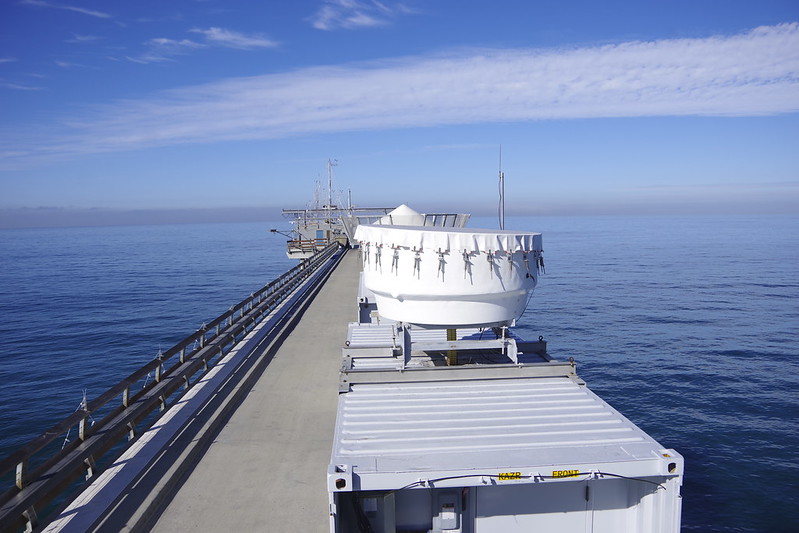ARM Radar Team Working on Fiscal Year 2024 Priorities
Published: 18 January 2024
Primary activities include management of radar operations and data processing
The Atmospheric Radiation Measurement (ARM) user facility seeks to provide high-quality radar observations to scientists worldwide. Because ARM radars are distributed worldwide, their maintenance, operations, and management require a substantial staffing commitment. However, existing staffing resources are limited. As a result, ARM develops priorities each fiscal year to make sure its radar engineering and data teams are working on activities that will have the biggest benefit and impact to the scientific community.
The entire radar team is currently addressing priorities laid out in the ARM Fiscal Year 2024 (FY2024) Radar Plan, including those related to management of radar operations and data processing.
Radar Operations

Primary activities for the radar team in FY2024 include a continued focus on operating and maintaining the Ka-Band ARM Zenith Radars (KAZRs), which, out of all ARM radars, have the most extensive long-term users. In FY2023, led by Iosif “Andrei” Lindenmaier, engineering team members completed a series of KAZR upgrades to help enhance ARM’s radar capabilities.
As well as overseeing KAZRs at ARM’s three fixed-location atmospheric observatories in FY2024, the radar team has been monitoring KAZR and scanning ARM cloud radar operations during the yearlong Eastern Pacific Cloud Aerosol Precipitation Experiment (EPCAPE) in La Jolla, California. The EPCAPE field campaign will conclude operations in February 2024.
While looking toward the end of EPCAPE, the team is gearing up to install and operate radars for new ARM mobile deployments.
Team members are getting ready to set up a second-generation KAZR and a set of scanning ARM cloud and precipitation radars in Alabama for ARM’s new Bankhead National Forest atmospheric observatory. The observatory will begin operations in early 2024.
From April 2024 to September 2025 in northwestern Tasmania, the team will monitor radar operations during the Cloud And Precipitation Experiment at kennaook (CAPE-k). This campaign will use a KAZR and a Marine W-Band ARM Cloud Radar (MWACR).
Another focus will be preparing a KAZR to deploy to Baltimore, Maryland, for the Coast-Urban-Rural Atmospheric Gradient Experiment (CoURAGE), which will begin in December 2024.
Data Processing

ARM data are labeled based on the level of processing they have undergone. A data file is considered a1-level after preliminary calibration factors have been applied and the raw measurements have been converted to geophysical units. Then there are b1-level data, which have undergone calibration, correction, and quality control processes beyond ARM’s standard quality checks and corrections.
In FY2024, the radar team is “dedicated to advancing calibrated b1 data processing, specifically for routine KAZR data calibration and scanning radar data in the field,” says Ya-Chien Feng, who leads the radar data team.
Team members are analyzing and processing b1-level data from the 2021–2023 Surface Atmosphere Integrated Field Laboratory (SAIL) campaign near Crested Butte, Colorado. This builds on work done in FY2023 for SAIL and the following campaigns:
- the 2019–2020 Multidisciplinary Drifting Observatory for the Study of Arctic Climate (MOSAiC) expedition in the central Arctic
- the 2019–2020 Cold-Air Outbreaks in the Marine Boundary Layer Experiment (COMBLE) in northern Norway
- the 2021–2022 TRacking Aerosol Convection interactions ExpeRiment (TRACER) near Houston, Texas.
The team is processing b1-level EPCAPE data with an aim to release them by the end of FY2024.
Provide Your Feedback
The FY2024 radar plan is now available for you to read on ARM.gov. If you have questions or feedback on the plan, please send them to Feng or Lindenmaier through the instrument mentor contact page.
Keep up with the Atmospheric Observer
Updates on ARM news, events, and opportunities delivered to your inbox
ARM User Profile
ARM welcomes users from all institutions and nations. A free ARM user account is needed to access ARM data.


















